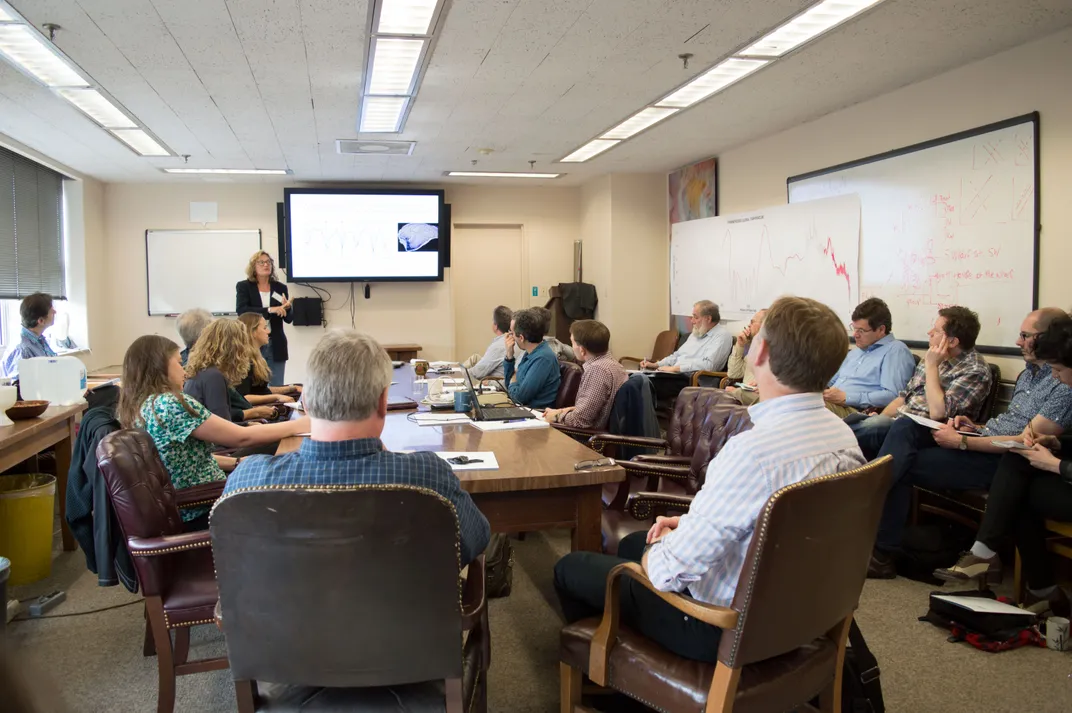NATIONAL MUSEUM OF NATURAL HISTORY
Leading Scientists Convene to Chart 500M Years of Global Climate Change
The National Museum of Natural History’s “Earth Temperature History Symposium” convened the world’s leading paleoclimate scientists to synthesize the latest scientific research in a comprehensive temperature curve of Earth’s past climates.
:focal(750x0:751x1)/https://tf-cmsv2-smithsonianmag-media.s3.amazonaws.com/blogging/featured/NMNH-2018-00570.jpg)
What is a “normal” global temperature increase for the Earth? How fast can it happen and how long does it take for the planet to recover? How do ecosystems change in response?
These are all questions that require urgent answers as the scientific community seeks to establish baselines against which we can compare modern changes in global temperature, and tries to predict how our planet will respond to the climate change we are seeing today. As paleobiologists at the Smithsonian’s National Museum of Natural History (NMNH), my colleagues and I are uniquely placed to answer these questions. The climate history of the Earth is recorded by rocks and fossils; we work to ”read” this record, and to understand what it can tell us to expect in the future.
The past 500 million years of the Earth’s history—since the time that many groups of plants and animals that we recognise today first evolved—provides a kind of “natural experiment” that demonstrates how the planet responded to large global temperature changes. Charting this history is a huge, collaborative task. In aid of this, NMNH recently convened eighteen scientists who are world authorities on climate in the geological past, for a two day meeting: the "Earth’s Temperature History Symposium." This was the first time that a group of researchers with such diverse climate-related expertise had been brought together.

The idea for this event was originally conceived back in 2016. NMNH paleobiologists Scott Wing and Brian Huber were presented with the daunting task of drawing a graph of the rise and fall of average global temperature over the past 500 million years, to be displayed in the National Fossil Hall when it reopens in summer 2019. Drawing this temperature curve required bringing together many lines of evidence, from ice cores, to fossil leaves and measurements of the chemical elements in ocean sediments.
While attempting this task, Wing and Huber found that there were very good estimates of global climate for many periods in the history of the Earth. However, some periods of time lacked data, leaving gaps in our scientific knowledge. The Symposium was designed to help address these gaps by providing an opportunity for paleoclimate scientists to synthesize all the work that has already been done, and identify how to solve the remaining problems.
With so many experts in the same place at the same time, the Symposium also presented a valuable opportunity for paleoclimate communication. I was part of a team of scientists and educators coordinating "Paleoclimate Day", an outreach event aimed at helping outstanding educators and DC area science communicators better understand and tell the interconnected story of life, climate and other Earth systems. The attendees listened to lightning talks from researchers on cutting-edge climate science and interacted directly with scientists to get to grips with paleoclimate theory. They also saw first-hand the fossil specimens housed at the NMNH that show how climate has changed over millions of years and that help scientists better understand and address 21st-century challenges such as biodiversity loss and climate change. Their enthusiastic response to this outreach effort highlighted how vital the following two days of scientific collaboration were.
/https://tf-cmsv2-smithsonianmag-media.s3.amazonaws.com/filer_public/87/8e/878e813d-670a-473c-aa43-0d22164f21fb/nmnh-2018-00616.jpeg)
A precise estimate of how the temperature of the Earth has changed over the last 500 million years is not something that can be mapped out in two days, but during the Symposium, we made significant progress towards that long-term goal. Experts in different types of evidence discussed how their data could be linked together, while climate modellers had the mathematical tools available to process primary data to fill in some of the gaps in the temperature record. Concrete plans were made to continue the conversation and address the remaining questions. In the end, the most important goal of the event was fulfilled—the group came to a consensus on how the temperature curve for the exhibit should be drawn, so keep an eye out for it when the National Fossil Hall reopens!

